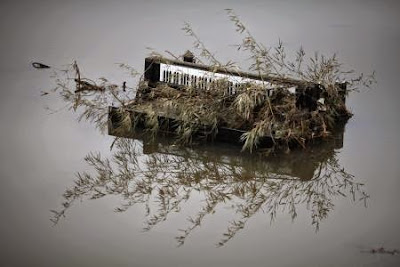A reporter and a cameraman from Jiji Tsushin went to Fukushima I Nuclear Power Plant on February 26, 2015 and made the video available on Jiji's site and on Youtube on March 2.
So what has changed? Reactor 3's top floor has been cleaned of debris, although the lower floors are still full of debris (1:50). Slightly murky Reactor 4's Spent Fuel Pool on the operating (top) floor is now empty except for a few control rods (3:10); workers had finished removing all 1,535 fuel assemblies from the pool in December last year. The cask used to transport the fuel assemblies from the pool to the common spent fuel pool on the ground is still at the pool side.
The cooling system for the frozen soil wall is housed in a new building (3:40). (Yes, they still do plan to build the frozen soil wall in the ground around the reactor buildings and turbine buildings.)
At about 50 seconds into the video, the reporter and the cameraman go to the location where they can see across the reactors (with Reactor 1 being the closest). The guide, a TEPCO worker, tells them to be brief because the radiation is high and there is nothing to shield the radiation (coming from the reactors?). The guide says, "It's 300 microsieverts/hour."
TEPCO's president Hirose just said in his address to TEPCO employees on the anniversary of the earthquake/tsunami/nuclear accident that there are over 7,000 workers working at Fukushima I Nuclear Power Plant.
Reuters Japan has a collection of 70 photographs titled "Four Years Ago in Japan". While the nuclear accident that was triggered by the massive earthquake and tsunami on March 11, 2011 has been the focus (often the only focus) for many, the devastation caused by the earthquake and tsunami looks just like a nuclear bomb detonated over Hiroshima and Nagasaki in August 1945, or incendiary bombs dropped on Tokyo on March 10, 1945.
Photo 1, Sendai City, Miyagi Prefecture
"Smoke rises from houses damaged by an earthquake and tsunami in Sendai, March 12, 2011.
REUTERS/Jo Yong-Hak"
Photo 8, Nihonmatsu City, Fukushima Prefecture
"A mother tries to talk to her daughter who has been isolated for signs of radiation after evacuating from the vicinity of Fukushima"s nuclear plants, at a makeshift facility to screen, cleanse and isolate people with high radiation levels in Nihonmatsu, March 14, 2011.
REUTERS/Yuriko Nakao"
Photo 9, surreal Otsuchi City, Iwate Prefecture on March 14, 2011
Photo 21, a piano, almost like an objet d'art, in Rikuzentakata City, Iwate Prefecture:
"A piano is submerged in water in the area devastated by tsunami in Rikuzentakat, March 21, 2011.
REUTERS/Damir Sagolj"
And this, I believe, is near Fukushima I Nuclear Power Plant, right by the ocean. Rows and columns of "fre-con" bags(flexible container bags) stuffed with contaminated soil and debris removed as the result of the government effort to "decontaminate" the villages, towns and cities in Fukushima, temporarily stored outside, right by the ocean.
When the earthquake/tsunami hit on March 11, 2011 in northern Japan, they feared the death toll would be in hundreds. Then over 1,000. Then thousands.
As of March 10, 2015, 15,891 people are dead, 2,584 missing, 6,152 injured (from wiki, data compiled by National Police Agency). The number for death does not include 3,194 deaths (as of September 30, 2014) after the earthquake and tsunami. Many, particularly the elderly, died of cold and unsanitary conditions at the shelters.








 Tokyo Time
Tokyo Time
![[Most Recent Quotes from www.kitco.com]](http://www.kitconet.com/charts/metals/gold/t24_au_en_usoz_2.gif)

